Anthropology 275 Lecture 2: Basic terminology
Disease in Prehistory
 Three references planes
Three references planes
Sagittal (midsagittal, median, midline):
divides the body into symmetrical right and left halves.
Parasagittal plane: any planar slice through the body paralleling the sagittal plane.
Coronal (frontal) plane: Perpendicular to the sagittal plane, divides the body into anterior and posterior halves.
Transverse (horizontal) plane: Perpendicular to sagittal and coronal planes, horizontal slice through the body.
Directional terms
Superior: towards the head
Inferior: away from the head
Anterior: towards the front of the body
Posterior: towards the back
Medial: towards the midline
Lateral: away from the midline
Proximal: nearest to the axial skeleton (usually long bones)
Distal: away from axial skeleton
Endocranial: inner surface of the cranial vault
Ectocranial: outer surface of the cranial vault
Skull: cranium + mandible
Postcranium: All of the bones EXCEPT the skull
Axial skeleton: Bones of the trunk-vertebrae (including sacrum), ribs and sternum
Appendicular skeleton: Bones of the limbs, including the innominates, scapulae and clavicles
Bones of the Skull
Frontal, Parietals (L&R), Temporals (L&R), Occipital, Maxillae (L&R)
Nasals (L&R), Zygomatics (L&R), Sphenoid, Mandible
Axial skeleton
Vertebrae: Cervical (n=7), Thoracic (n=12), Lumbar (n=5), Sacrum, Coccyx
Sternum
Ribs (generally 12 pairs)
Appendicular Skeleton
Arm: Scapula (L & R), Clavicle (L & R), Humerus (L & R), Radius (L & R), Ulna (L & R)
Carpals (wrist bones; 8L & 8R)
Metacarpals (bones of the palm; 5L & 5R)
Phalanges (singular phalanx, finger bones; 5 proximal, 4 middle, 5 distal for each hand)
Leg: Innominate (L & R), Femur (L & R), Patella (L & R), Tibia (L & R)
Fibula (L & R), Tarsals (ankle, heel and proximal portion of base of foot; 7L & 7R)
Metatarsals (distal base of foot)
Phalanges (singular phalanx, toe bones; 5 proximal, 4 middle, 5 distal for each foot)
 Three references planes
Three references planes